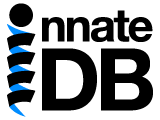| Homo sapiens Gene: TSPAN6 | |||||||||||||||||||
|---|---|---|---|---|---|---|---|---|---|---|---|---|---|---|---|---|---|---|---|
| Summary | |||||||||||||||||||
| InnateDB Gene | IDBG-79141.6 | ||||||||||||||||||
| Last Modified | 2014-10-13 [Report errors or provide feedback] | ||||||||||||||||||
| Gene Symbol | TSPAN6 | ||||||||||||||||||
| Gene Name | tetraspanin 6 | ||||||||||||||||||
| Synonyms | T245; TM4SF6; TSPAN-6 | ||||||||||||||||||
| Species | Homo sapiens | ||||||||||||||||||
| Ensembl Gene | ENSG00000000003 | ||||||||||||||||||
| Encoded Proteins |
tetraspanin 6
tetraspanin 6
tetraspanin 6
|
||||||||||||||||||
| Protein Structure | |||||||||||||||||||
| Useful resources | Stemformatics EHFPI ImmGen | ||||||||||||||||||
| Entrez Gene | |||||||||||||||||||
| Summary |
The protein encoded by this gene is a member of the transmembrane 4 superfamily, also known as the tetraspanin family. Most of these members are cell-surface proteins that are characterized by the presence of four hydrophobic domains. The proteins mediate signal transduction events that play a role in the regulation of cell development, activation, growth and motility. This encoded protein is a cell surface glycoprotein and is highly similar in sequence to the transmembrane 4 superfamily member 2. The use of alternate polyadenylation sites has been found for this gene. [provided by RefSeq, Jul 2008] The protein encoded by this gene is a member of the transmembrane 4 superfamily, also known as the tetraspanin family. Most of these members are cell-surface proteins that are characterized by the presence of four hydrophobic domains. The proteins mediate signal transduction events that play a role in the regulation of cell development, activation, growth and motility. The protein encoded by this gene is a cell surface glycoprotein and is highly similar in sequence to the transmembrane 4 superfamily member 2 protein. It functions as a negative regulator of retinoic acid-inducible gene I-like receptor-mediated immune signaling via its interaction with the mitochondrial antiviral signaling-centered signalosome. This gene uses alternative polyadenylation sites, and multiple transcript variants result from alternative splicing. [provided by RefSeq, Jul 2013] |
||||||||||||||||||
| Gene Information | |||||||||||||||||||
| Type | Protein coding | ||||||||||||||||||
| Genomic Location | Chromosome X:100627109-100639991 | ||||||||||||||||||
| Strand | Reverse strand | ||||||||||||||||||
| Band | q22.1 | ||||||||||||||||||
| Transcripts |
|
||||||||||||||||||
| Interactions | |||||||||||||||||||
| Number of Interactions |
This gene and/or its encoded proteins are associated with 9 experimentally validated interaction(s) in this database.
|
||||||||||||||||||
| Gene Ontology | |||||||||||||||||||
Molecular Function |
|
||||||||||||||||||
| Biological Process |
|
||||||||||||||||||
| Cellular Component |
|
||||||||||||||||||
| Orthologs | |||||||||||||||||||
|
Species
Mus musculus
Bos taurus
|
Gene ID
Gene Order
Not yet available
|
||||||||||||||||||
| Cross-References | |||||||||||||||||||
| SwissProt | |||||||||||||||||||
| TrEMBL | |||||||||||||||||||
| UniProt Splice Variant | |||||||||||||||||||
| Entrez Gene | |||||||||||||||||||
| UniGene | |||||||||||||||||||
| RefSeq | NM_001278740 NM_001278741 NM_001278743 NM_003270 | ||||||||||||||||||
| HUGO | |||||||||||||||||||
| OMIM | |||||||||||||||||||
| CCDS | CCDS14470 CCDS76001 | ||||||||||||||||||
| HPRD | |||||||||||||||||||
| IMGT | |||||||||||||||||||
| EMBL | |||||||||||||||||||
| GenPept | |||||||||||||||||||
| RNA Seq Atlas | |||||||||||||||||||
